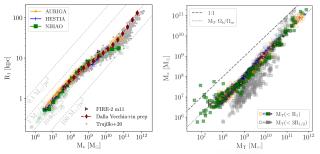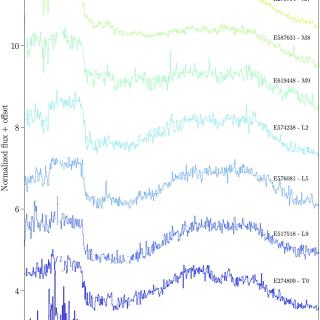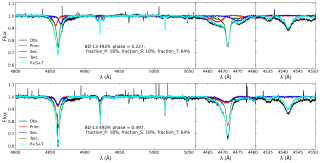Recent observations of the rotation curve of M31 show a rise of the outer part that cannot be understood in terms of standard dark matter models or perturbations of the galactic disk by M31?s satellites. Here, we propose an explanation of this dynamical feature based on the in?uence of the magnetic ?eld within the thin disk. We have considered standard mass models for the luminous mass distribution, a Navarro?Frenk?White model to describe the dark halo, and we have added up the contribution to the rotation curve of a magnetic ?eld in the disk, which is described by an axisymmetric pattern. Our conclusion is that a signi?cant improvement of the ?t in the outer part is obtained when magnetic effects are considered. The best-?t solution requires an amplitude of ?4 ?G with a weak radial dependence between 10 and 38 kpc.
Advertised on
References
(2010) The Astrophysical Journal Letters, Volume 723, Issue 1, pp. L44-L48
It may interest you
-
 Measuring galaxy sizes is essential for understanding how they were formed and evolved across time. However, traditional methods based on l ight concentration or isophotal densities often lack a clear physical meaning. A recent study from Trujillo+20 explores a more physically motivated definition: the radius R 1, where the stellar surface density falls to 1 solar masses per parsec square —roughly the threshold for gas to form stars in galaxies like the Milky Way. In this work, Arjona-Gálvez+25 uses over 1,000 galaxies from several state-of-the-art cosmological simulations (AURIGA, HESTIAAdvertised on
Measuring galaxy sizes is essential for understanding how they were formed and evolved across time. However, traditional methods based on l ight concentration or isophotal densities often lack a clear physical meaning. A recent study from Trujillo+20 explores a more physically motivated definition: the radius R 1, where the stellar surface density falls to 1 solar masses per parsec square —roughly the threshold for gas to form stars in galaxies like the Milky Way. In this work, Arjona-Gálvez+25 uses over 1,000 galaxies from several state-of-the-art cosmological simulations (AURIGA, HESTIAAdvertised on -
 The Near-Infrared Spectrometer and Photometer (NISP) on board the Euclid space mission has obtained near-infrared (NIR) spectra of millions of objects, including hundreds of ultracool dwarfs (UCDs). Euclid observations retrieve images and slitless spectra simultaneously. This observing mode marks a new era in the discovery of new objects, such as L- and T-type dwarfs, which can be found from direct identification through the H2O and CH4 absorption bands. NISP spectral resolution (R ∼ 450) is enough to classify the objects by the spectral type using known standard templates. Q1 provided moreAdvertised on
The Near-Infrared Spectrometer and Photometer (NISP) on board the Euclid space mission has obtained near-infrared (NIR) spectra of millions of objects, including hundreds of ultracool dwarfs (UCDs). Euclid observations retrieve images and slitless spectra simultaneously. This observing mode marks a new era in the discovery of new objects, such as L- and T-type dwarfs, which can be found from direct identification through the H2O and CH4 absorption bands. NISP spectral resolution (R ∼ 450) is enough to classify the objects by the spectral type using known standard templates. Q1 provided moreAdvertised on -
 The most massive stars in the universe are often born and evolve in binary and multiple systems — that is, in pairs or groups bound by their mutual gravity. Understanding how they interact with each other is key to explaining everything from their formation to the impact they have on the galaxies they inhabit. The MONOS project (Multiplicity Of Northern O-type Spectroscopic systems) aims to study these systems in the northern sky, combining spectroscopic observations (which analyze light split into its component colors to measure stellar velocities and physical properties) with photometryAdvertised on
The most massive stars in the universe are often born and evolve in binary and multiple systems — that is, in pairs or groups bound by their mutual gravity. Understanding how they interact with each other is key to explaining everything from their formation to the impact they have on the galaxies they inhabit. The MONOS project (Multiplicity Of Northern O-type Spectroscopic systems) aims to study these systems in the northern sky, combining spectroscopic observations (which analyze light split into its component colors to measure stellar velocities and physical properties) with photometryAdvertised on